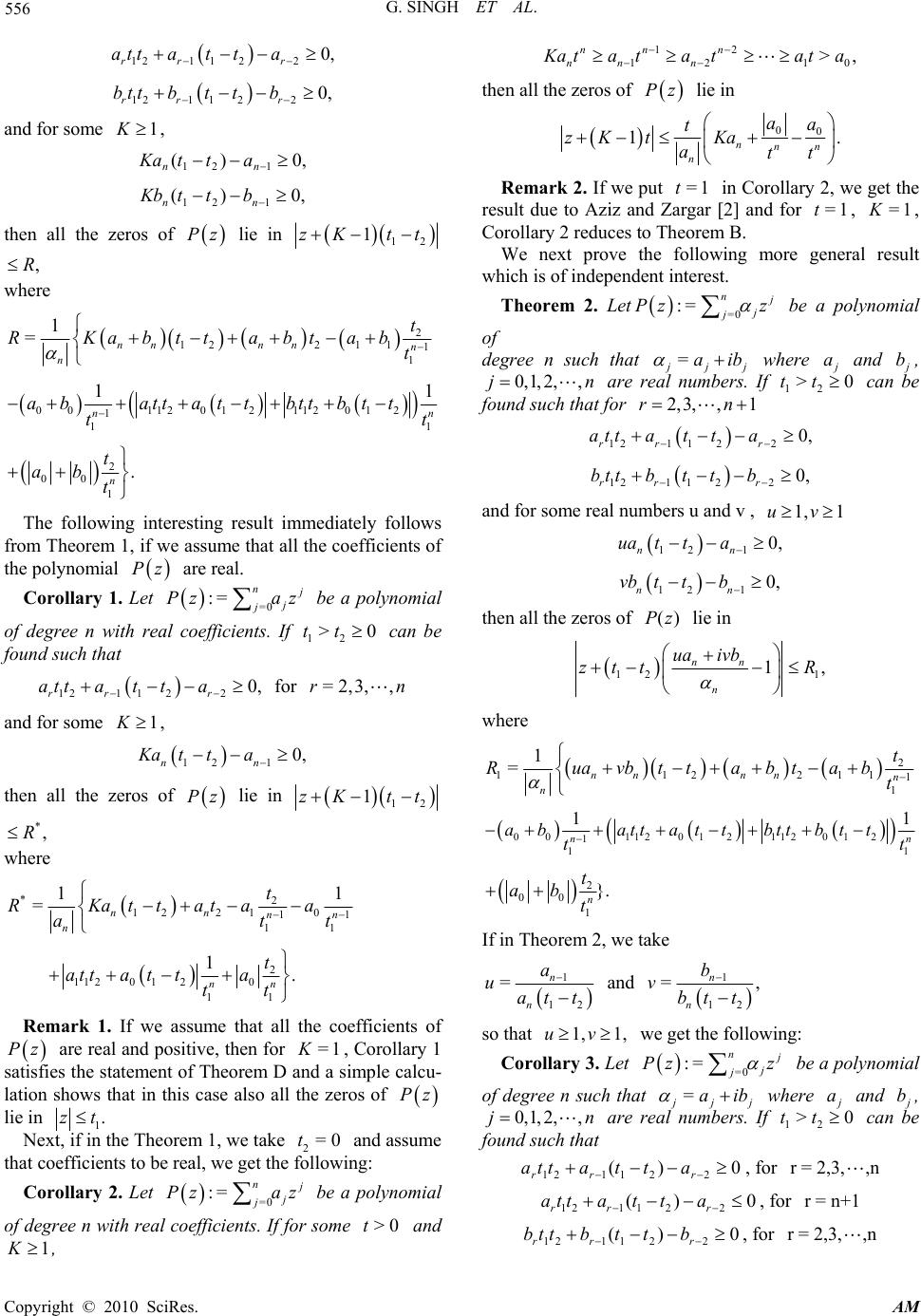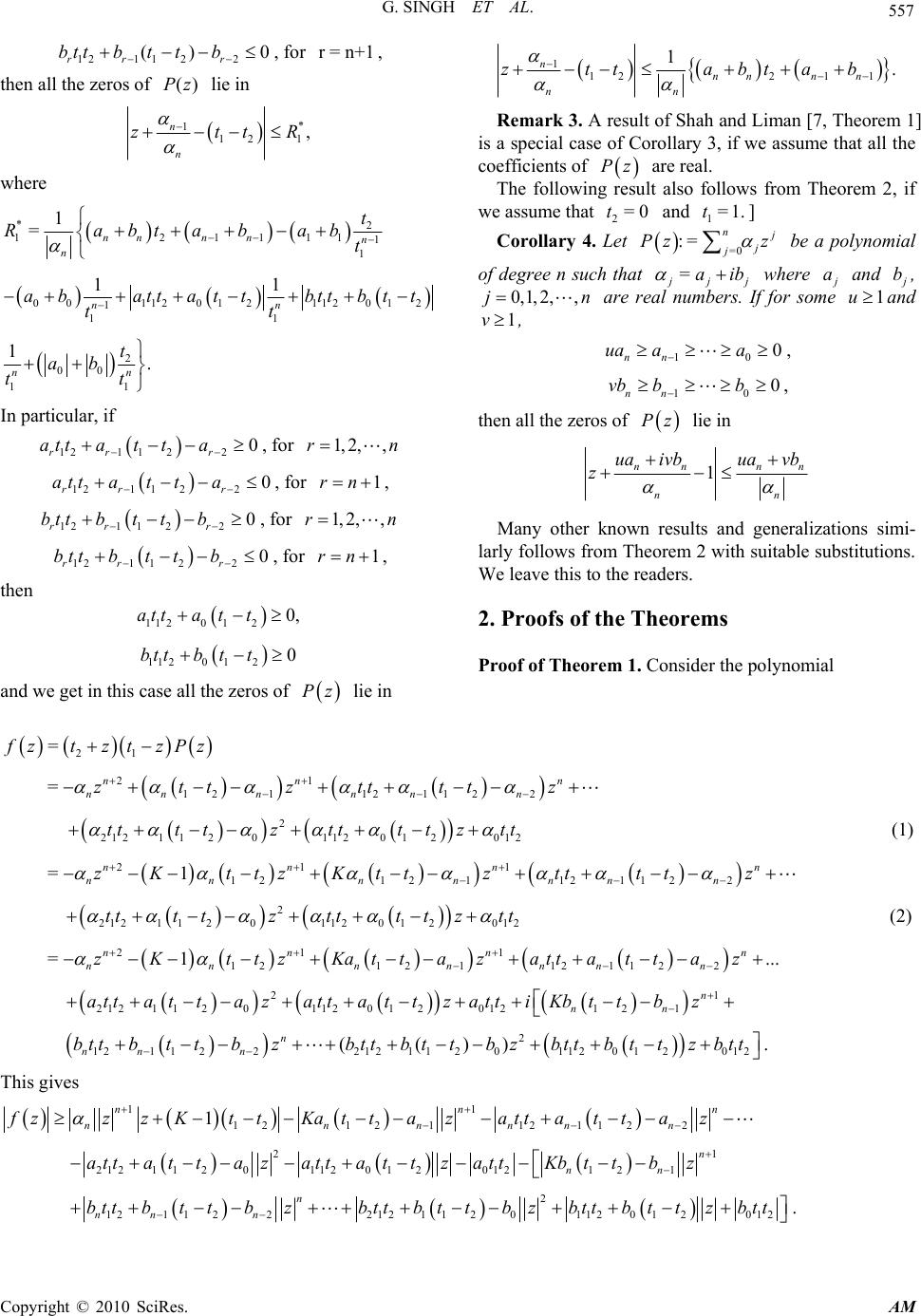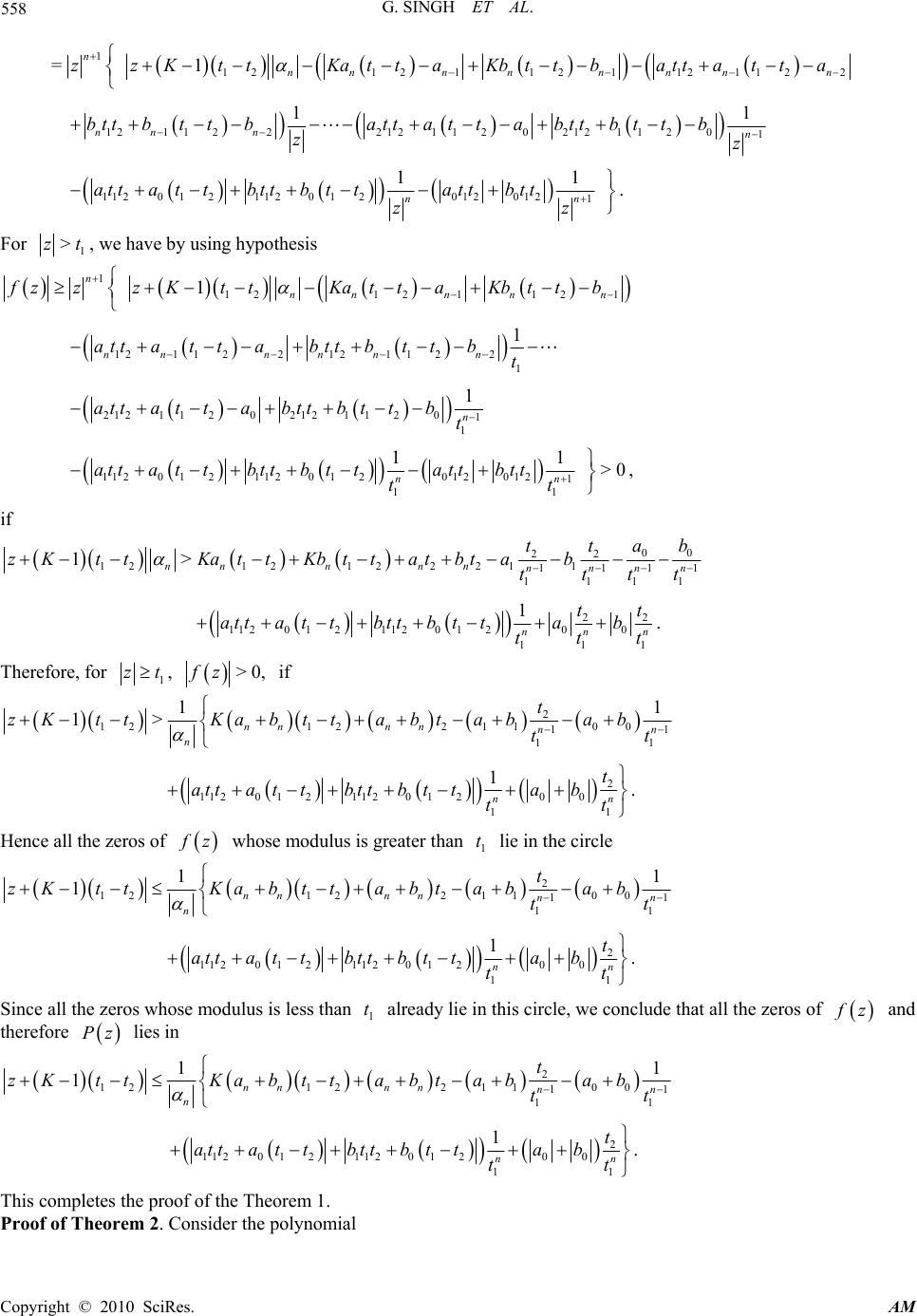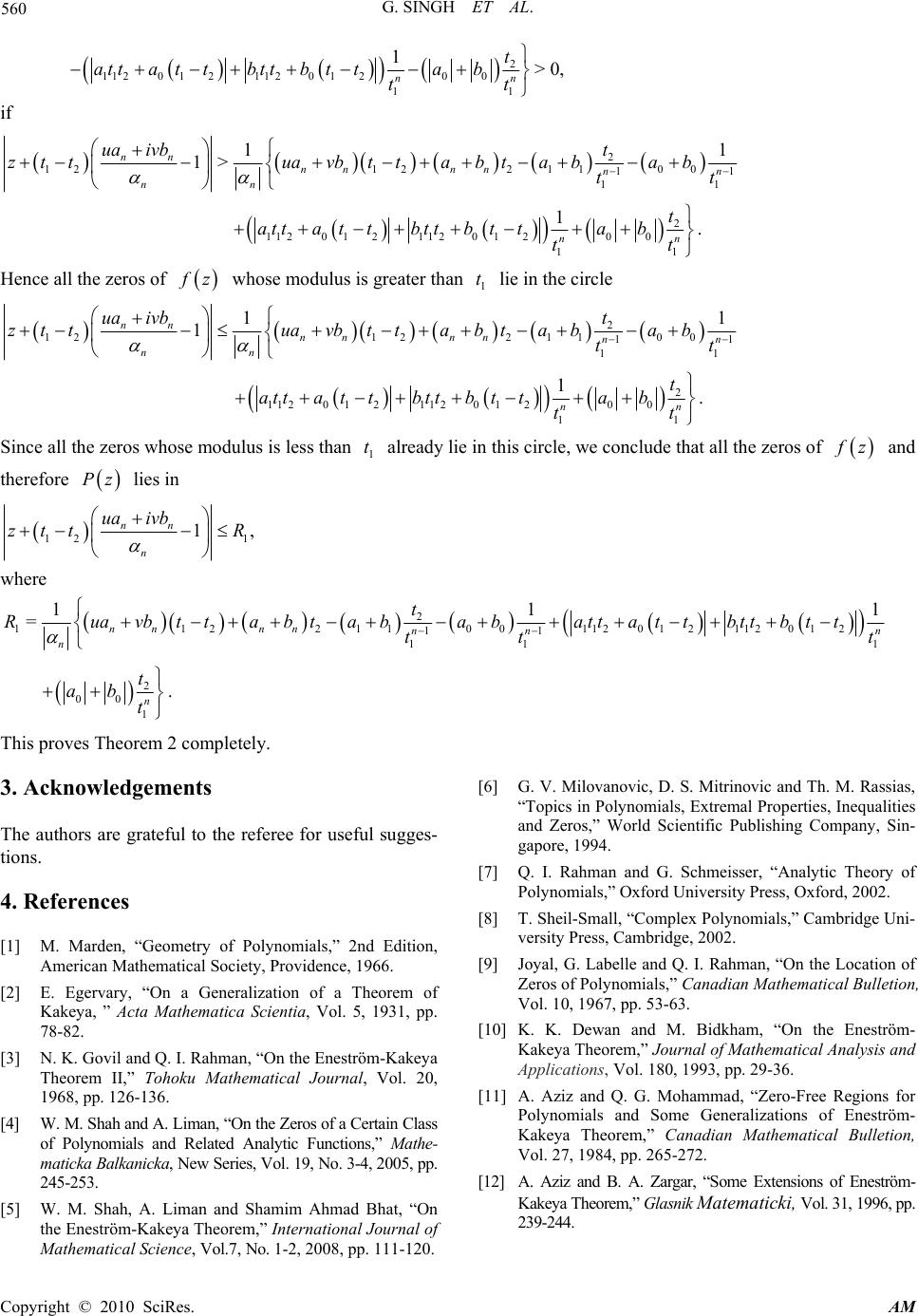Paper Menu >>
Journal Menu >>
 Applied Mathematics, 2010, 3, 555-560 doi:10.4236/am.2010.16073 Published Online December 2010 (http://www.SciRP.org/journal/am) Copyright © 2010 SciRes. AM On The Eneström-Kakeya Theore m Gulshan Singh1, Wali Mohammad Shah2 1Bharat hiar Univers ity, Coimbatore, India 2Department of Mat hem at ic s, Kashmir University, Srinagar, India E-mail: gulshansingh1@rediffmail.com , wmshah@rediffmail.com Received August 9, 2010; revised November 17, 2010; accepted November 20, 2010 Abstract In this paper, we prove some generalizations of results concerning the Eneström-Kakeya theorem. The re- sults obtained considerably improve the bounds by relaxing the hypothesis in some cases. Keywords: Polynomial, Zeros, Eneström-Kakeya theorem 1. Introduction and Statement of Results The following result due to Eneström and Kakeya [1] is well known in the theory of distribution of the zeros of polynomials. Theorem A. If =0 := n j j j Pz az is a polynomial of degree n such that 12 10 , nn n aa aaao then Pz does not vanish in >1z In the literature, [2-8], there exist extensions and ge- neralizations of Eneström-Kakeya theorem. Joyal, La- belle and Rahman [9] extended this theorem to a poly- nomial whose coefficients are monotonic but not neces- sarily non negative by proving the following result. Theorem B. Let =0 := n j j j Pz az be a polynomial of degree n such that 12 10 , nn n aa aaa then all the zeros of ()Pz lie in 00 1. n n zaaa a Dewan and Bidkham [10] generalized Theorem B and proved the following: Theorem C. Let =0 := n j j j Pz az be a polynomial of degree n such that for some >0t and 0<,n 11 1110 , nn nn ata tatattaa then Pz has all the zeros in the circle 00 21. n nn n a t zaaa att By using Schwarz's Lemma, Aziz and Mohammad [11] generalized Eneström-Kakeya theorem in a different way and proved the following: Theorem D. Let =0 := n j j j Pz az be a polynomial of degree n with real positive coefficients. If 12 >0tt can be found such that 121 1220 rr r attatta , for =1,2, ,1rn 11 ==0, n aa then all the zeros of Pz lie in 1 zt Aziz and Zargar [12] also relaxed the hypothesis of Eneström-Kakeya theorem in a different way and proved the following result. Theorem E. Let =0 := n j j j Pz az be a polynomial of degree n such that for some 1 K , 12 10 >0, nn n Kaaaa a then all the zeros of Pz lie in 1.zK K While studying Theorem E, a natural question arises that what happens if we relax the hypothesis of Theorem D in a similar way and only assume that 121 1220 rr r attatta , for =2,3,,rn In this paper, we study such a case and prove a more general result from which many known results follow on a fairly uniform procedure. Infact we prove: Theorem 1. Let =0 := n j j j Pz z be a polynomial of degree n such that = j jj aib where j a and j b, 0,1 ,jn are real numbers and if 12 >0tt can be found such that for =2,3, ,rn  G. SINGH ET AL. Copyright © 2010 SciRes. AM 556 121 1220, rr r attat ta 121 1220, rr r bttbttb and for some 1 K , 0,)( 121 nn attKa 0,)( 121 nn bttKb then all the zeros of Pz lie in 12 1zK tt ,R where 2 1221 11 1 1 =nn nnn n t RKabttabt ab t 001120 121120 12 1 11 11 nn abattatt bttbtt tt 2 00 1 . n t ab t The following interesting result immediately follows from Theorem 1, if we assume that all the coefficients of the polynomial Pz are real. Corollary 1. Let =0 := n j j j Pz az be a polynomial of degree n with real coefficients. If 12 >0tt can be found such that 121 1220, rr r attat ta for =2,3, ,rn and for some 1K, 12 1 0, nn Katta then all the zeros of Pz lie in 12 1zK tt *,R where *2 122 10 11 11 11 =nn nn n t RKattataa att 2 1120120 11 1. nn t atta tta tt Remark 1. If we assume that all the coefficients of Pz are real and positive, then for =1 K , Corollary 1 satisfies the statement of Theorem D and a simple calcu- lation shows that in this case also all the zeros of Pz lie in 1.zt Next, if in the Theorem 1, we take 2=0t and assume that coefficients to be real, we get the following: Corollary 2. Let =0 := n j j j Pz az be a polynomial of degree n with real coefficients. If for some >0t and 1 K , 12 12 10 >, nn n nn n K atatatata then all the zeros of Pz lie in 00 1. nnn n aa t zK tKa att Remark 2. If we put 1=t in Corollary 2, we get the result due to Aziz and Zargar [2] and for 1=t, 1= K , Corollary 2 reduces to Theorem B. We next prove the following more general result which is of independent interest. Theorem 2. Let =0 := n j j j Pz z be a polynomial of degree n such that jjj iba = where j a and j b, 0,1,2, ,jn are real numbers. If 0>21 tt can be found such that for 2,3, ,1rn 1211220, rr r attat ta 121 1220, rr r bttbttb and for some real numbers u and v , 11, vu 12 1 0, nn uatta 12 1 0, nn vbttb then all the zeros of )(zP lie in 12 1 1, nn n ua ivb ztt R where 2 112211 1 1 1 =nn nnn n t Ruavbttabtab t 0011201 2112012 1 11 11 nn abattatt bttbtt tt 2 00 1 }. n t ab t If in Theorem 2, we take 1 12 =n n a uat t and 1 12 =, n n b vbt t so that 1,1, vu we get the following: Corolla ry 3 . Let =0 := n j j j Pz z be a polynomial of degree n such that jjj iba = where j a and j b, 0,1,2, ,jn are real numbers. If 0>21 tt can be found such that 0)( 221121 rrrattatta , for r = 2,3,,n 121122 () 0 rr r attat ta , for r = n+1 0)( 221121 rrrbttbttb , for r = 2,3,,n  G. SINGH ET AL. Copyright © 2010 SciRes. AM 557 121 122 () 0 rr r bttbt tb , for r = n +1, then all the zeros of )(zP lie in * 112 1 , n n zttR where *2 121111 1 1 1 =nnn nn n t Rabtabab t 0 0112012112 012 1 11 11 nn abattatt bttbtt tt 2 00 11 1. nn t ab tt In particular, if 1211220 rr r attat ta , for 1, 2,,rn 121 1220 rr r attat ta , for 1rn, 121 1220 rr r bttbttb , for 1, 2,,rn 121 1220 rr r bttbttb , for 1rn, then 1120 120,atta tt 1120 120bttb tt and we get in this case all the zeros of Pz lie in 11221 1 1. nnnn n nn zttabtab Remark 3. A result of Shah and Liman [7, Theorem 1] is a special case of Corollary 3, if we assume that all the coefficients of Pz are real. The following result also follows from Theorem 2, if we assume that 0= 2 t and 1.= 1 t] Corollary 4. Let =0 := n j j j Pz z be a polynomial of degree n such that jjj iba = where j a and j b, 0,1,2, ,jn are real numbers. If for some 1uand 1v, 10 0 nn ua aa , 10 0 nn vb bb , then all the zeros of Pz lie in 1 nn nn nn ua ivbua vb z Many other known results and generalizations simi- larly follows from Theorem 2 with suitable substitutions. We leave this to the readers. 2. Proofs of the Theorems Proof of Theorem 1. Consider the polynomial 21 = f ztztzPz 21 12112 1122 =nn n nn n nnn zttzttttz 2 2121 1201120 12012 ttttzttttztt (1) 21 1 1212112 1122 =1 nn nn nn nnnnn zK ttzKttz ttttz 2 2121 1201120 12012 ttttzttttztt (2) 21 1 1212112 1122 =1 ... nn nn nn nnnnn zKttz Kattaz attattaz 2 1 21211 2011201 20121 21n nn attattazattattzattiKbttb z 2 1211 2221211 2011201 2012 (()) n nn n bttbttbzbttbttbzbttbtt zbtt . This gives 11 1212112 1122 1 nnn nnnnnn fzzzKttKattazattattaz 2 1 2121120112012012121 n nn attattazattattzattKbttbz 2 1211 2221211 20112012012 n nn n bttbtt bzbttbtt bzbttbttzbtt .  G. SINGH ET AL. Copyright © 2010 SciRes. AM 558 1 12121121121122 =1 n nnn nnnnn zzKttKattaKbttb attatta 121 12221211202121 1201 11 nn nn bttbtt battattabttbtt b zz 112012112 0120120121 11 nn attattbttbttattbtt zz . For 1 >zt, we have by using hypothesis 1 1212112 1 1 n nnn nn fzzzKt tKat taKbt tb 1211 221211221 1 nnnnn n attat tabttbt tbt 212112021211201 1 1 n attat tabttbt tbt 1120 121120 120120121 11 11 >0 nn attattbttbttattbtt tt , if 00 22 12121222 11 1 111 1 111 1> nnnnnnnnn ab tt z KttKattKbttatbtab t ttt 22 1120 121120 1200 111 1 nnn tt attatt bttbttab ttt . Therefore, for 1 zt, >0,fz if 2 121221 100 11 11 11 1> nn nnnn n t z KttKabttabtabab tt 2 1120 121120 1200 11 1 nn t attattbttbtta b tt . Hence all the zeros of f z whose modulus is greater than 1 t lie in the circle 2 121221 100 11 11 11 1nnnnnn n t zKttKabttabtabab tt 2 1120 121120 1200 11 1 nn t attattbttbtta b tt . Since all the zeros whose modulus is less than 1 t already lie in this circle, we conclude that all the zeros of f z and therefore Pz lies in 2 121221 100 11 11 11 1nnnnnn n t zKttKabttabtabab tt 2 1120 121120 1200 11 1 nn t attattbttbtta b tt . This completes the proof of the Theorem 1. Proof of Theorem 2. Consider the polynomial  G. SINGH ET AL. Copyright © 2010 SciRes. AM 559 21 = f ztztzPz 21 12112 1122 =... nn n nn n nnn zttzttttz 2 2121 120112012012 ttttzttttztt 21 2 121121122212 1120 = ... nn n nn n nnn zatt azattatt a zattatt az 1 11201 20121211211 22 nn nnnn n attattzattibtt bzbttbtt bz 2 2121 120112012012 bttbtt bzbttbttzbtt 21 1 12121121122 =1 nn nn nn nnnnn zuattzuatt azattattaz 211 212 112011201201212121 1nn nnn attattazatt att zattivbttzvbttbz 2 1211 2221211 2011201 2012 ... n nn n bttbtt b zbttbtt bzbttbttzbtt 211 12121121122 =nnnn nnnn nnnnn zuaivbttzuattazattattaz 2 1 21211201120120121 21 (()) n nn attat tazattat tzattivbt tbz 2 1211 22212112011201 2012 n nn n bttbtt b zbttbttbzbttbttzbtt . This gives 1 1 1212112 1122 1 nnn nn nnnnnn n ua ivb fzzzttuatt azattattaz 2 1 21211 2011201 20121 21 n nn attattazattattzattvbttb z 2 121 1222121120112012012 n nn n bttbtt bzbttbtt bzbttbttzbtt . 1 1212112 1 =1 nnn nnnnn n ua ivb zzttuatt avbtt b 1211 22121122112012112012 11 nnnnn nn attattabttb ttbattattbttbtt zz 012 0121 1 n attbtt z For 1 >zt, we have 1 12121121 1 nnn nnn nn n ua ivb fzzzttuat tavbt tb 1211 2212112211201 211201 2 11 11 nnnnn nn atta ttabttbttbattattbttbtt tt 012 0121 1 1 n attbtt t . By using hypothesis, this gives 12 121221 100 11 11 1 1 nnn nnn nnnn n ua ivbt fzzzttuavbttabtabab tt  G. SINGH ET AL. Copyright © 2010 SciRes. AM 560 2 112012112 01200 11 1>0, nn t attattbttbtta b tt if 2 121221 100 11 11 11 1> nn nn nnnn nn ua ivbt zttuavbttabtabab tt 2 1120 121120 1200 11 1 nn t attattbttbttab tt . Hence all the zeros of f z whose modulus is greater than 1 t lie in the circle 2 121221100 11 11 11 1 nn nn nnnn nn ua ivbt zttuavbttabt abab tt 2 1120 121120 1200 11 1 nn t attattbttbttab tt . Since all the zeros whose modulus is less than 1 t already lie in this circle, we conclude that all the zeros of f z and therefore Pz lies in 12 1 1, nn n ua ivb ztt R where 2 11221 100112012112012 11 11 1 111 =nn nnnn n n t Ruavbttabt ababattattbttbtt tt t 2 00 1 n t ab t . This proves Theorem 2 completely. 3. Acknowledgements The authors are grateful to the referee for useful sugges- tions. 4. References [1] M. Marden, “Geometry of Polynomials,” 2nd Edition, American Mathematical Society, Providence, 1966. [2] E. Egervary, “On a Generalization of a Theorem of Kakeya, ” Acta Mathematica Scientia, Vol. 5, 1931, pp. 78-82. [3] N. K. Govil and Q. I. Rahman, “On the Eneström-Kakeya Theorem II,” Tohoku Mathematical Journal, Vol. 20, 1968, pp. 126-136. [4] W. M. Shah and A. Liman, “On the Zeros of a Certain Cla ss of Polynomials and Related Analytic Functions,” Mathe- maticka Balkanicka, New Series, Vol. 19, No. 3-4, 2005, pp. 245-253. [5] W. M. Shah, A. Liman and Shamim Ahmad Bhat, “On the Eneström-Kakeya Theorem,” International Journal of Mathematical Science, Vol.7, No. 1-2, 2008, pp. 111-120. [6] G. V. Milovanovic, D. S. Mitrinovic and Th. M. Rassias, “Topics in Polynomials, Extremal Properties, Inequalities and Zeros,” World Scientific Publishing Company, Sin- gapore, 1994. [7] Q. I. Rahman and G. Schmeisser, “Analytic Theory of Polynomials,” Oxford University Press, Oxford, 2002. [8] T. Sheil-Small, “Complex Polynomials,” Cambridge Uni- versity Press, Cambridge, 2002. [9] Joyal, G. Labelle and Q. I. Rahman, “On the Location of Zeros of Polynomials,” Canadian Mathematical Bulletion, Vol. 10, 1967, pp. 53-63. [10] K. K. Dewan and M. Bidkham, “On the Eneström- Kakeya Theorem,” Journal of Mathematical Analysis and Applications, Vol. 180, 1993, pp. 29-36. [11] A. Aziz and Q. G. Mohammad, “Zero-Free Regions for Polynomials and Some Generalizations of Eneström- Kakeya Theorem,” Canadian Mathematical Bulletion, Vol. 27, 1984, pp. 265-272. [12] A. Aziz and B. A. Zargar, “Some Extensions of Eneström- Kakeya Theorem,” Glasnik Matematicki, Vol. 31, 1996, pp. 239-244. |

